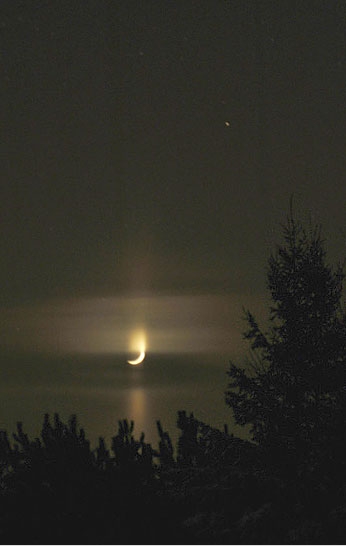Moon pillars
Moon Pillars: A Spectacular Atmospheric Phenomenon
Moon pillars, also known as lunar pillars, are a captivating atmospheric phenomenon that can be observed when the moon is bright and shining against a dark enough sky. These ethereal columns of light add a touch of magic to the night sky, creating a stunning visual spectacle for those lucky enough to witness them. In this article, we will delve deeper into the fascinating world of moon pillars, exploring their formation, characteristics, and the conditions necessary for their occurrence.
What are Moon Pillars?
Moon pillars are vertical columns of light that appear to extend upward from the moon's surface. They are an optical phenomenon caused by the reflection and refraction of moonlight by ice crystals in the Earth's atmosphere. Similar to their cousin, the sun pillar, which occurs during sunrise or sunset, moon pillars can create a mesmerizing display of light and color in the night sky.
Formation of Moon Pillars
Moon pillars form when moonlight interacts with horizontally oriented ice crystals present in the atmosphere. These ice crystals act as tiny mirrors, reflecting and refracting the light, which then appears as a vertical beam extending from the moon. The orientation of the ice crystals is crucial for the formation of moon pillars, as they need to be aligned horizontally to create the desired effect.
Characteristics of Moon Pillars
Moon pillars typically appear as thin, vertical shafts of light that extend above and below the moon. They often resemble tall, luminous columns, adding a sense of grandeur to the celestial scenery. The length and brightness of moon pillars can vary depending on several factors, including the abundance and shape of ice crystals in the atmosphere.
Factors Influencing Moon Pillar Appearance
Several factors contribute to the appearance and visibility of moon pillars:
-
Weather Conditions: Clear skies are essential for observing moon pillars, as any cloud cover can obstruct the view of these delicate phenomena.
-
Moon Brightness: Moon pillars are most visible when the moon is bright and shining against a dark sky. A full or nearly full moon often provides the optimal conditions for observing moon pillars.
-
Atmospheric Conditions: The presence of ice crystals in the atmosphere is crucial for the formation of moon pillars. These ice crystals can be found in high-altitude clouds, such as cirrus clouds, which are composed of tiny ice particles.
Other Atmospheric Optics Phenomena Associated with Moon Pillars
Moon pillars are often accompanied by other atmospheric optics phenomena, enhancing the overall visual spectacle. Some of these phenomena include:
-
Moon Halos: A halo around the moon caused by the refraction of moonlight through ice crystals in the atmosphere.
-
Lunar Coronas: Circular rings of colored light that encircle the moon, formed by diffraction and interference of light as it passes through water droplets or ice crystals.
-
Lunar Parhelia: Also known as moon dogs, these are bright spots of light that appear on either side of the moon. They are caused by the reflection and refraction of moonlight by hexagonal ice crystals.
Capturing the Beauty of Moon Pillars
Photographers and astronomy enthusiasts often strive to capture the beauty of moon pillars through their lenses. By using long-exposure photography techniques and adjusting camera settings, it is possible to capture the intricate details and vibrant colors of these atmospheric wonders. Patience and persistence are key when attempting to photograph moon pillars, as they can be elusive and require optimal viewing conditions.
Conclusion
Moon pillars are a captivating atmospheric phenomenon that adds an enchanting touch to the night sky. These vertical columns of light, created by the reflection and refraction of moonlight by ice crystals in the atmosphere, create a stunning visual spectacle for observers. Understanding the formation, characteristics, and factors influencing moon pillars allows us to appreciate the complexity and beauty of our atmosphere. So, the next time you find yourself gazing at a bright moon against a dark sky, keep an eye out for these magical moon pillars and let yourself be mesmerized by their celestial splendor.

Lunar pillars may be seen when the moon is bright and shining against a dark enough sky.
Here, upper and lower pillars echo a crescent moon.
Seen on January 6, 2003 by Lauri Kangas (more of his images) of Ontario, Canada.
Image ©2003 Lauri Kangas, shown with permission.
Note: this article has been automatically converted from the old site and may not appear as intended. You can find the original article here.
Reference Atmospheric Optics
If you use any of the definitions, information, or data presented on Atmospheric Optics, please copy the link or reference below to properly credit us as the reference source. Thank you!
-
<a href="https://atoptics.co.uk/blog/moon-pillars/">Moon pillars</a>
-
"Moon pillars". Atmospheric Optics. Accessed on April 25, 2024. https://atoptics.co.uk/blog/moon-pillars/.
-
"Moon pillars". Atmospheric Optics, https://atoptics.co.uk/blog/moon-pillars/. Accessed 25 April, 2024
-
Moon pillars. Atmospheric Optics. Retrieved from https://atoptics.co.uk/blog/moon-pillars/.